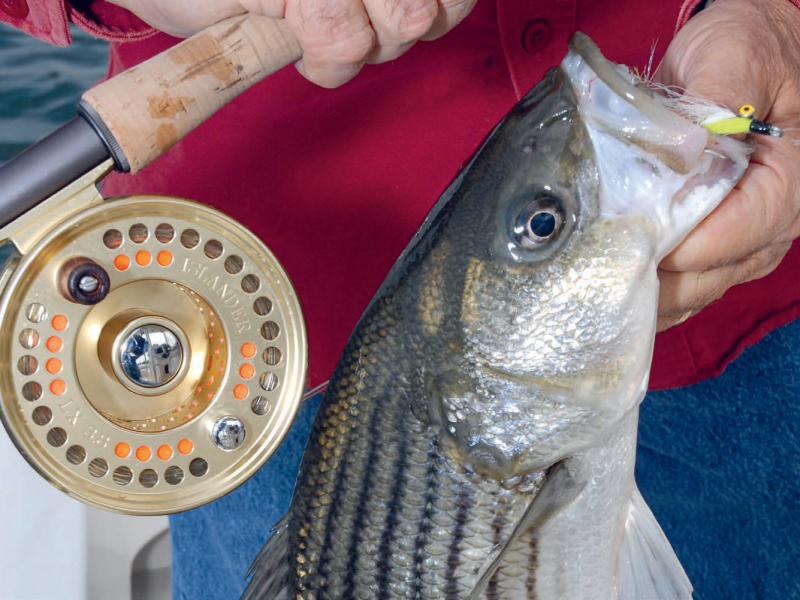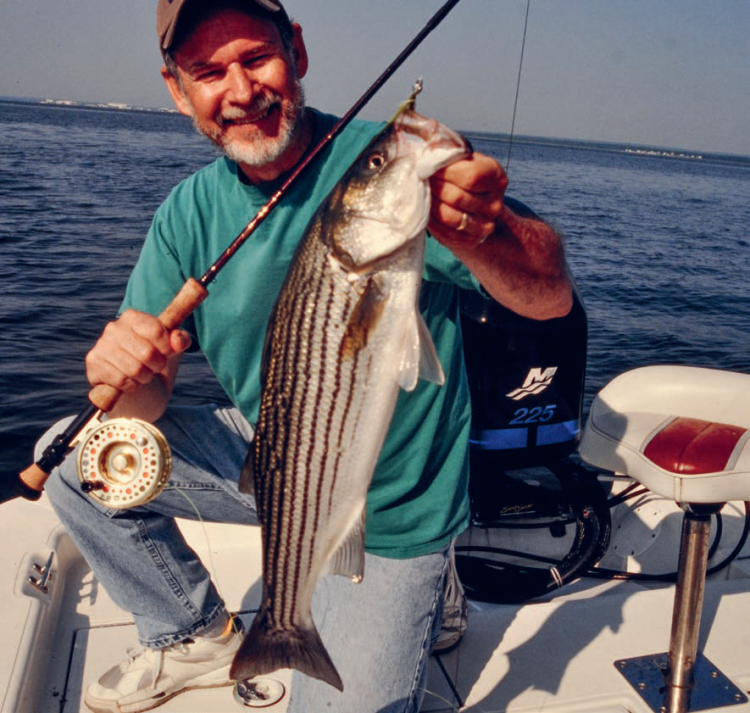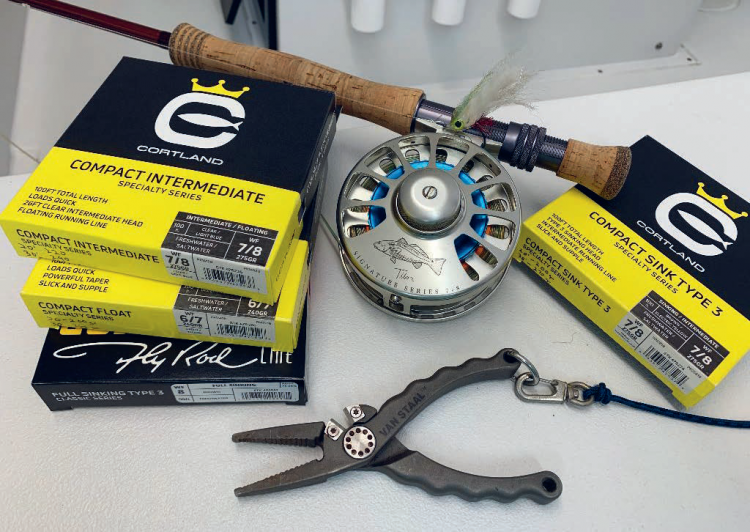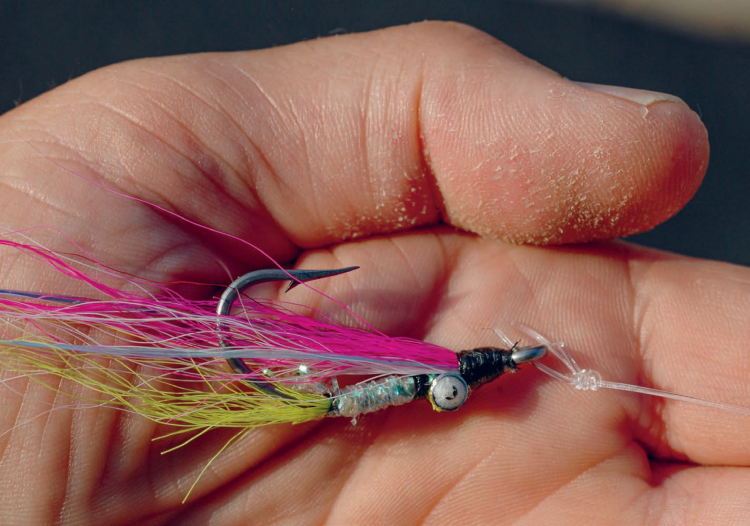Spring Fly Fishing for Striped Bass
Rising temperatures, more daylight, the higher sun angle, and hordes of bait team up to put out the welcome mat for migrating striped bass.

Rising temperatures, more daylight hours, the higher sun angle, and hordes of bait team up to put out the welcome mat for migrating striped bass in April and May. These are two special months to spend fly fishing for striped bass. Impatient striper addicts may try for their first bent rod in late March just because it’s good to be on the water, limber up, and make the first few casts, but Apr. 15 is a more reliable startup date, and the fishing ops improve with each passing day.
(Note: On The Water is reader-supported. When you buy through links on our site, we may earn an affiliate commission.)
Fly Fishing Tips for Striped Bass: Q & A
What is the ideal water temperature for striper fly fishing?
To get tight to the first bass, you have to figure out where they are. Bait fishermen will get bites on the ocean side, but the surf is still too chilly and inconsistent for spring flyrodders to expect decent fishing, so chances of finding bass are far better in the back bays, rivers, and salt ponds along the coast. Back-bay water temperatures are usually 5 to 10 degrees warmer than the ocean (sometimes more), which makes stripers much more active. The warmer temperatures and higher sun angle also accelerate the activity of local bait.
The ideal water temperature is about 55 degrees. I keep a handheld Orvis fishing thermometer tied to a short string on my wader bag to check the temp when wading or kayaking, and on my flats skiff I rely on a Simrad for water temperature, bottom contours, and fish location. This data is essential for my logbook.
Prime backcountry areas are generally shallow with dark bottoms of mud, gravel, eelgrass, or dark sand that hold the sun’s heat.
When is the best time of the day to go fly fishing for stripers?
While summer and fall striped bass fly fishing is often best at dawn, spring striper fishing is generally better after the sun has had a chance to radiate its warmth through the day, so fly fishing from noon to dark should increase your odds dramatically.

How does wind affect striper behavior?
Spring striped bass usually aren’t loners. They gather in small, tight schools, so after a day or two of sunny weather with not too much wind, when you fool one bass, you’ll probably catch another in that same spot. Wind can shift warm water from one side of a bay to the other or even hold a pocket of warm water in place for several days. Two days of a steady wind from any direction will probably deliver particularly good fishing on the third day if conditions remain the same.
Which tide do stripers prefer in the spring?
Tide definitely plays a big part. A sunny afternoon with a falling tide is prime time and many good bass fishermen, fly or spin, mark their calendars or leave notes on their cell phones to keep track of the optimum falling tides. Not only are goodies washing out of the creeks, but the warm water unleashes the striper’s disposition to attack a fly. Flyrodders with many years’ experience will hit the places where they caught early fish in past years, so there’s nothing as helpful as an accurate, detailed logbook to solve the where-are-they-biting riddle.
How does the moon affect striped bass fishing?
Moon phase has a strong effect on tide levels, and the additional water pushed into back bays and rivers at high tides means super-strong cur[1]rents as the water flows out. This year, we’ll have new moons on April 12 and May 11, and full moons on Apr. 27 and May 26, so planning your trips a few days before or after these times can really deliver a good bite. While some fly fishers say they don’t do well on the day of a new or full moon, most everyone agrees that the several days before and after those phases are great times to fish.
Tidal current isn’t always steady, and the water’s speed may pulse – at times accelerating, and other times slowing down. The start of the dropping tide may start leisurely, then quickly accelerate; this momentary speed-up often triggers a great spring bass feeding spree. As the water level decreases, the bass move to the next location, perhaps down the creek or into deeper water in the bay or river, so it’s a good idea to have a plan in mind that follows the tide and the bass from spot A to B to C and so on.
Veterans usually have several pre-planned spots to fish and work them in sequence as the tide falls (or rises), following pockets of warm water, bait, and striped bass. They’re looking for rip lines, current seams, and any edge that creates water movement. Drop-offs at marsh edges are traditional favorite spring spots because the escaping water pulls out crabs, grass shrimp, clam spat, worms, and baitfish.
Fly Fishing for Striped Bass: Tips for the Spring
Choose the Right Fly Line
Fly-line choice is dependent on water depth and water current. On a spring fly-fishing trip many years ago to Tilghman Island in Chesapeake Bay, I partnered with a friend who loved fly fishing the Bay’s eastern shore. We cast to 2-foot drop-offs along marsh edges with floating lines and caught plenty of micro-size bass at many small creek outflows.
In contrast, a spring trip in Narragansett Bay’s deeper-water coves with Capt. Jim White of White Ghost Charters called for a 250-grain sink-tip. In coastal spots with strong currents, around bridges, or plumbing a deep hole, a 350-grain tip may be needed. If you aren’t deep, no bites for you!

Salty fly-rodders encounter a variety of opportunities all along the coast, so whether casting from a kayak or skiff, it makes good business sense to carry fly rods rigged with float, intermediate, and sink-tip lines to quickly adapt to changing fishing positions or water speed. Let’s use one of my favorite bridges as an example. It has shallow water on its south side, with a pair of 3-foot cuts in the mussel beds that causes the current to run through them pretty quickly. An intermediate or 250-grain sinktip is needed to overcome the lifting force of the speeding current. On the north side of the same bridge, the water depth is uniformly around 12 feet, so a 350-grain sink-tip is the way to go. On its southeast side, there is a very shallow mud flat that can be fished only with a floater.
Picking a Striped Bass Fly Rod
Fast and extra-fast fly rods are in great favor these days, but a more moderate rod is easier to cast with sink-tip lines. I still use an ancient Albright XX 7-weight (Lou Tabory’s old “chuck and duck” series) that has a moderate action and handles sink-tips just fine. Other good choices are TFO’s Mangrove series, Orvis Clearwater Series, St. Croix Imperial Series and Scott’s Tidal collection. A friend of mine, Capt. Bill Crandell, started using a Sage Maverick last year and he says it throws sink-tip lines quite well for him.
Fly fishing for stripers in the quiet backwaters is the most fun with a 6- or 7-weight rod (8-weight at the most) and any of them designed for saltwater use will handily throw most any popular springtime fly, even big flies as long as they shed water on the lift to start the backcast.
Striped Bass Flies
There are plenty of great flies for spring, and everyone has their favorites. Perhaps more important than the fly pattern is the fly’s color. Spring weather forecasts can often be quite windy, with choppy water that turns brown and muddy, so a bright fly can visibly punch through dirty water better than a dark one. Ditto when fishing deep where there’s less light to ignite the visual appeal of the fly.
A personal favorite fly is the Clouser Deep Minnow tied in pink, white, and chartreuse. If the tail or bottom color is chartreuse and the top wing is pink, most fly fishers call it the Electric Chicken; if the colors are reversed and the top wing is chartreuse and the tail is pink, it’s called the Tutti Fruitti. However, I’ve met flyrodders who swap the names, proving that it doesn’t really matter what the fly is called; it’s the combo of the colors that’s important, not which one is on top.

In April, spearing and killies are the most populous bait, followed by anchovies and grass shrimp in May. They are only a few inches in length, so the most effective patterns will be tied on 2, 1, or 1/0 hooks. Because the water can be discolored, it’s good to have some patterns tied full, with lots of material to improve its visibility. Bass also sense the water movement of a bushy fly as it pushes water on the retrieve. By contrast, a sparsely-tied pattern is more realistic in clear water, where bass can see that a fly tied like a shaving brush looks fake. By May, there’s a good chance that blueback herring will be on hand, and perhaps some menhaden too, so a well-stocked fly box should have a handful of larger patterns ready for action.
The Wooly Bugger is an underrated but wonderfully effective spring striped bass fly that also fools weakfish because of its “shrimpy” profile. Other “shrimpy” profiles
The Pop Fleyes Jiggy and the ubiquitous Clouser Deep Minnow are other time-tested patterns that many fly fishers consider to be go-to patterns. Besides the Electric Chicken mentioned above, tie some in brown, olive, and tan to imitate mummichogs (a.k.a. mud minnows, killies, or minnies) with a touch of chartreuse flash.
In shallow water, a suspending fly can be ideal, like a Lefty Deceiver or flatwing.
Retrieve Speed
In water temperatures just below 60 degrees, striped bass may still be a little slow to react to a fly, which calls for a slow-steady retrieve with intermittent pauses. A leisurely retrieve speed gives these water-chilled fish the chance to see the fly and attack. The momentary pause lets the fly sink, especially if it’s weighted, and bass often eat the fly as it drops, meaning you’ll come tight on the next strip. Hot-rod retrieves usually don’t get as many bites as a slow-paced one.
In very shallow water, ignore the need to go deep and tie on a popper bug or gurgler retrieved slowly. Wait a few seconds in between each pause before twitching pr popping the bug again. The pause is often the key ingredient to fooling the bass, especially with a popper tied with a marabou tail and palmered hackle at the rear of the body to provide lifelike motion even when it’s at rest.
Leave a Reply